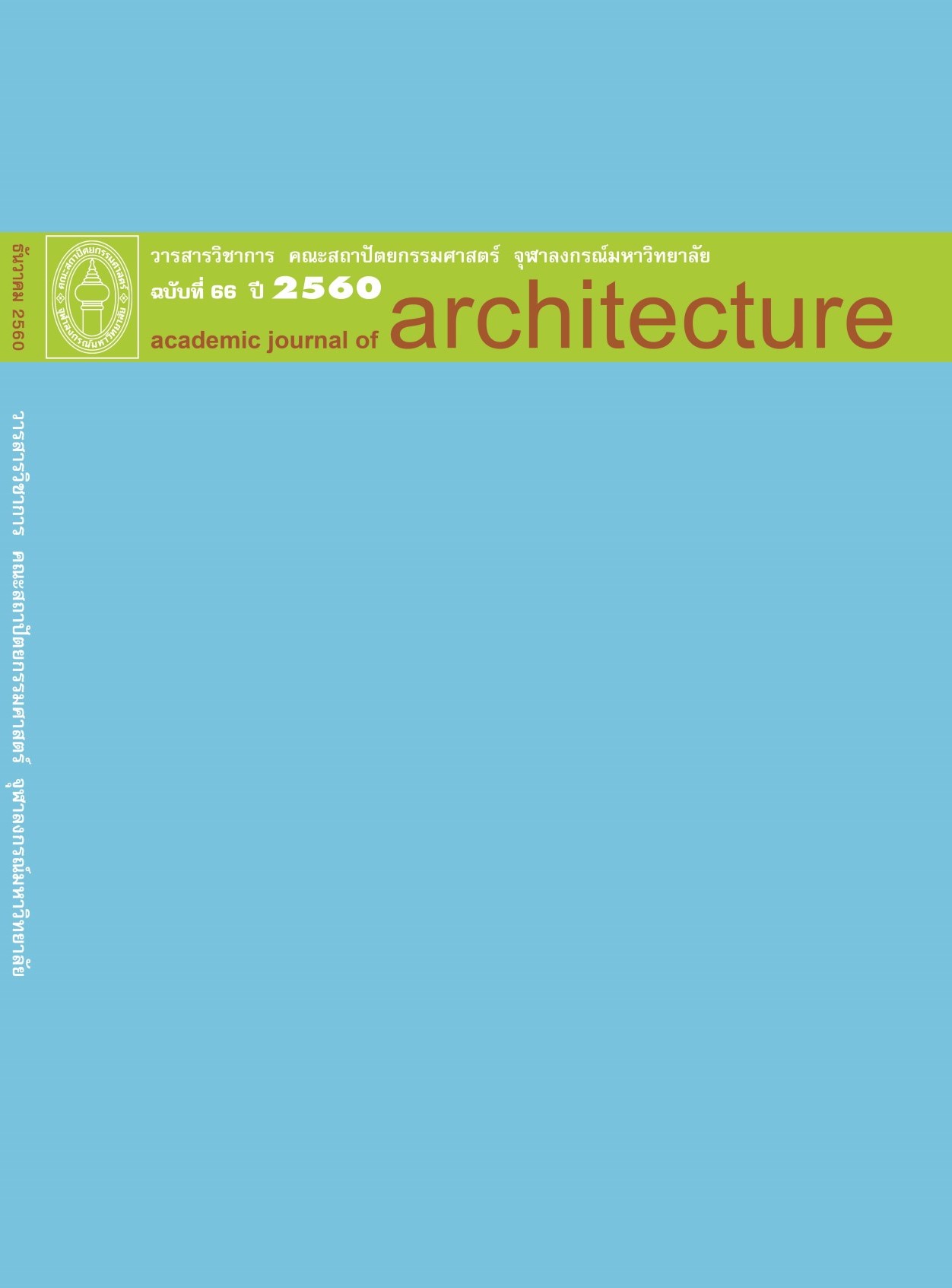Attitudes Towards Changes in Scenic from Chao Phraya Riverfront Extension Project: Temple and Historic Monument Area
Main Article Content
Abstract
This research was conducted to examine people’s attitude towards the changes in riverfront landscape of Chao Phraya River due to the future waterfront area extension. It aims to understand what people think is the proper riverfront extension development. To find this out, 4 simulations of riverfront extension were created in different places, including ancient temples and historic sites. There are 4 steps in the study which are studying previous theories and related thesis, analyzing ancient temples and historic sites background information, creating simulate photo-questionnaire for interview by using photo montage technique, and collecting and Analyzing data. This research was conducted to examine people’s attitude towards the changes in riverfront landscape of Chao Phraya River due to the future waterfront area extension. It aims to understand what people think is the proper riverfront extension development. To find this out, 4 simulations of riverfront extension were created in different places, including ancient temples and historic sites. There are 4 steps in the study which are studying previous theories and related thesis, analyzing ancient temples and historic sites background information, creating simulate photo-questionnaire for interview by using photo montage technique, and collecting and Analyzing data. According to the results, people’s attitude towards the changes in Chao Phraya riverfront extension relates to three factors. The main factor is the present physical condition, historic and architectural value of the scene depicted by the pictures. Another factor is the design of the riverfront extension which can be divided into 3 aspects: a) Level of walkway and its material, dam’s edge level, and structure, b) The width of the extended area, c) The accessibility of the walkway to the existing river edge. Lastly, the least-related factor is the respondent backgrounds; each of the respondents has its level of favors, acknowledgment and the best suitability for the current environment. Moreover, the research found out that the most undesirable opinion falls on the over-width of the river extension. Finally this research can be used for further study which may provide more in-depth details in order to develop the design for the river extension in the future.
Article Details
References
2. กระทรวงวัฒนธรรม. กรมศาสนา. พระอารามหลวง เล่ม 1. กรุงเทพมหานคร: โรงพิมพ์ชุมนุมสหกรณ์การเกษตรแห่งประเทศไทย, 2551.
3. กรมศิลปากร. “ระบบฐานข้อมูลแหล่งมรดกทางศิลปวัฒนธรรมธรรม และระบบภูมิสารสนเทศ โครงการสำรวจแหล่งมรดกทางศิลปวัฒนธรรม.” สืบค้น 6 มิถุนายน 2559. http://www.gis.finearts.go.th
4. กรมศิลปากร. กองจดหมายเหตุแห่งชาติ. จดหมายเหตุการอนุรักษ์กรุงรัตนโกสินทร์. กรุงเทพฯ: กรม, 2525.
5. กรมศิลปากร. กองโบราณคดี. ทฤษฎีและแนวทางปฏิบัติการอนุรักษ์อนุสรณ์สถานและแหล่งโบราณคดี. กรุงเทพมหานคร: หิรัญพัฒน์, 2533.
6. กรมศิลปากร. กองโบราณคดี. แนวปฏิบัติในการสงวนรักษาโบราณสถาน ตามพระราชบัญญัติโบราณสถาน โบราณวัตถุ ศิลปวัตถุ และพิพิธภัณฑสถานแห่งชาติ พ.ศ. 2504 แก้ไขเพิ่มเติม พ.ศ. 2535. กรุงเทพมหานคร: รุ่งศิลป์การพิมพ์, 2548.
7. “ข้อมูลแผนที่ดาวเทียม จาก Google Maps.” สืบค้น 20 มีนาคม 2559. https://www.google.co.th/maps.
8. คณะกรรมการวัฒนธรรมแห่งชาติ. แนวทางการจัดการภูมิทัศน์วัฒนธรรม. กรุงเทพฯ: อมรินทร์, 2549.
9. ไตรรัตน์ จารุทัศน์. คู่มือปฏิบัติวิชาชีพสถาปัตยกรรม การออกแบบสภาพแวดล้อมและสิ่งอำนวยความสะดวกสำหรับทุกคน (Universal Design Code of Practice). กรุงเทพมหานคร: สมาคมสถาปนิกสยาม ในพระบรม-ราชูปถัมภ์, 2552.
10. ทรรศชล ปัญญาทรง. “แนวทางการออกแบบเพื่อพัฒนา ทางเท้าในย่านพาณิชยกรรมอโศก กรุงเทพมหานคร.” วิทยานิพนธ์ปริญญามหาบัณฑิต สาขาวิชาการออกแบบชุมชนเมือง คณะสถาปัตยกรรมศาสตร์ จุฬาลงกรณ์มหาวิทยาลัย, 2551.
11. นนทิชา ถาวรไพบูลย์บุตร. “กรอบอ้างอิงการรับรู้ทางสายตา.” บทความฟื้นวิชา 17, 3 (กันยายน- ธันวาคม 2555): 25-29.
12. รุจิโรจน์ อนามบุตรและวิลาสินี สุขสว่าง. คู่มือการประเมินผลกระทบทางสายตา จากสิ่งก่อสร้างประเภท อาคาร. กรุงเทพมหานคร: สานักนโยบายและแผนทรัพยากรธรรมชาติและสิ่งแวดล้อม, 2555.
13. วิมลสิทธิ์ หรยางกูร. พฤติกรรมมนุษย์กับสภาพแวดล้อม: มูลฐานทางพฤติกรรมเพื่อการออกแบบและวางแผน. พิมพ์ครั้งที่ 6. กรุงเทพมหานคร: โรงพิมพ์แห่งจุฬา- ลงกรณ์มหาวิทยาลัย, 2549.
14. วิล์ลญา สงค์อิ่ม. “ผลกระทบทางสายตาของอาคารสูงเพื่อการอยู่อาศัยที่มีต่อวัดในบริเวณกรุงเทพมหานคร.” วิทยานิพนธ์ปริญญามหาบัณฑิต สาขาวิชาภูมิสถาปัตยกรรม คณะสถาปัตยกรรมศาสตร์ มหาวิทยาลัยศิลปากร, 2557.
15. สนิท สมัครการ. การเปลี่ยนแปลงทางวัฒนธรรมกับการพัฒนาการของสังคม. กรุงเทพมหานคร: สำนักงานกิจการโรงพิมพ์ องค์การสงเคราะห์ทหารผ่านศึก, 2545.
16. อดิศร ศรีเสาวนันท์และวีระ อินพันทัง. “แนวความคิดเรื่องสถานที่ และปรากฏการณ์วิทยา กับการศึกษางานสถาปัตยกรรมพื้นถิ่น.” วารสารวิชาการ คณะสถาปัตยกรรมศาสตร์ มหาวิทยาลัยขอนแก่น 15, 1(มกราคม-มิถุนายน 2559): 1-20.


